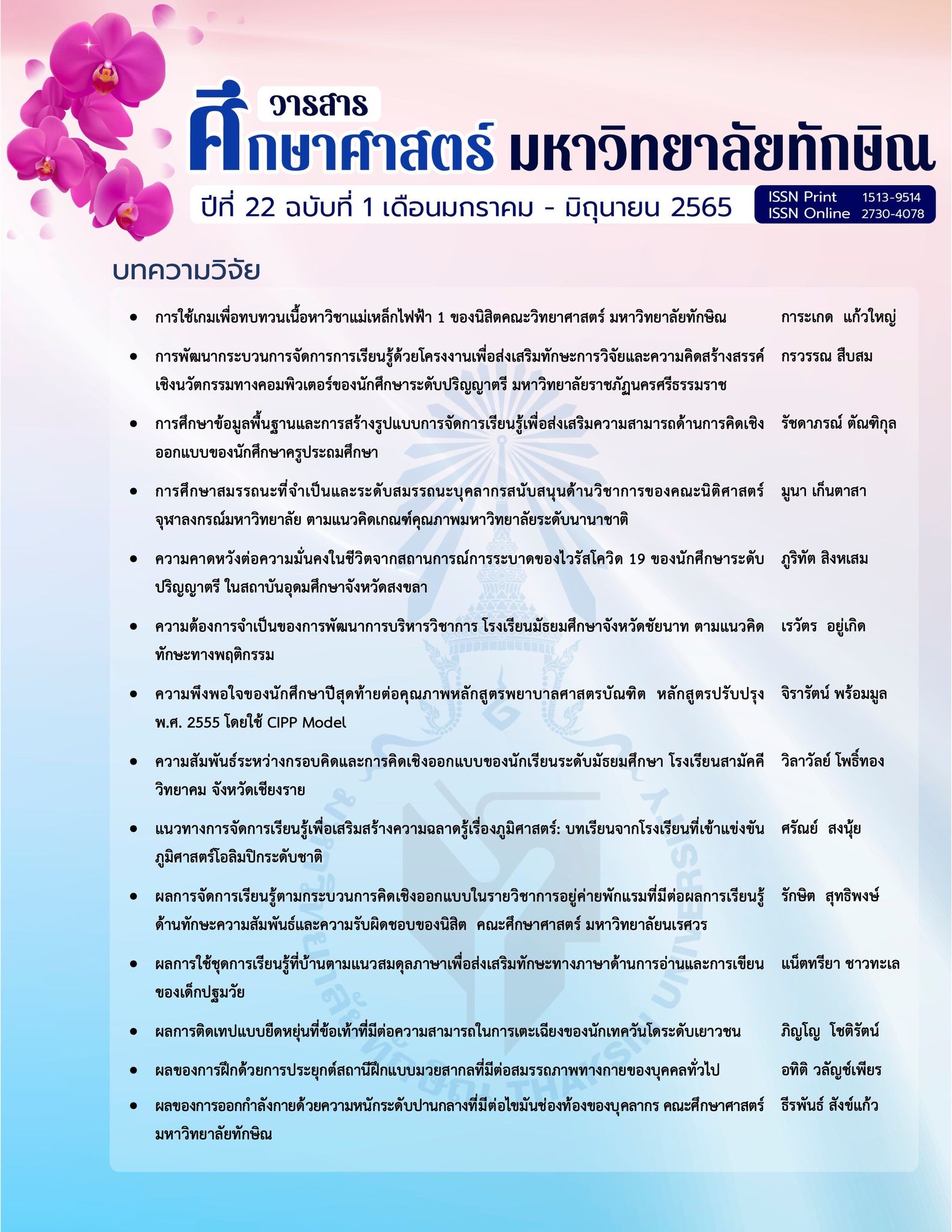The Effect of Elastics Taping on Round Kick Performance in Youth’s Taekwondo Players.
Main Article Content
Abstract
The purpose of this study was to examine the effect of ankle balance taping with elastic tape on round kick performance in youth’s taekwondo players. Eighteen blackbelt youth’s taekwondo players were participated in this study, there are screened with inclusion and excluded criteria performed. Then randomized into experiment group and control group, 9 people in each group. After that participants in both group pre-test round kick performance, then move on room in each group to rest 45 minutes. Next step, control group were adhere rigid tape on skin around the area Tibialis Anterior, that placebo tape, while experiment group were adhere rigid tape on skin around the ankle and heel. After taping in each group, post - test was performed, when completed on both group, research assistant got to collected data sheet. Subsequently, The Mann – Whitney U Test and The Wilcoxon Signed – Rank Test were used in order to analysis the data. The alpha level was set at 0.05.
This study found that Elastic tape had statistically significant influence on round kick performance (Sig. 2-tailed = 0.04). In addition, the experimental group had shown after adhered tape on ankle were increase than before taping was to significant (Sig. 2-tailed = 0.01). While, there were no statistically significant in control group (Sig. 2-tailed = 0.35). Conclusion, this study had demonstrated that elastic taping method on ankle were improves the round kick performance in youth's taekwondo players.
Article Details

This work is licensed under a Creative Commons Attribution-NonCommercial-NoDerivatives 4.0 International License.
ในกรณีที่กองบรรณาธิการ หรือผู้เชี่ยวชาญ ซึ่งได้รับเชิญให้เป็นผู้ตรวจบทความวิจัย หรือ บทความทางวิชาการมีความเห็นว่าควรแก้ไขความบกพร่อง ทางกองบรรณาธิการจะส่งต้นฉบับให้ ผู้เขียนพิจารณาจัดการแก้ไขให้เหมาะสมก่อนที่จะลงพิมพ์ ทั้งนี้ กองบรรณาธิการจะยึดถือความคิด เห็นของผู้เชี่ยวชาญเป็นเกณฑ์
References
การกีฬาแห่งประเทศไทย. (2558). คู่มือผู้ฝึกสอนกีฬาเทควันโด. กรุงเทพฯ, งานพัฒนาองค์ความรู้ กองวิชาการกีฬา ฝ่ายสารสนเทศและวิชาการกีฬา การกีฬาแห่งประเทศไทย.
ไพศาล วรคำ. (2558). การวิจัยทางการศึกษา. (พิมพ์ครั้งที่ 7). มหาสารคาม: ตักสิลาการพิมพ์.
สาริษฐ์ บัวเล็ก. (2555). ผลของการกระตุ้นผิวหนังด้วยเทปยืด ต่อความรู้สึกรับรู้ตำแหน่งภายในข้อเท้า และ H-reflex ของกล้ามเนื้อ Gastrocnemius. (ปริญญาวิทยาศาสตรมหาบัณฑิต, สาขาเวชศาสตร์การกีฬา คณะแพทยศาสตร์). กรุงเทพมหานครฯ : จุฬาลงกรณ์มหาวิทยาลัย.
Asghar Akbari, Alireza Sarmadi, Parisa Zafardanesh. (2014). “The Effect of Ankle Taping and Balance Exercises on Postural Stability Indices in Healthy Women”, Journal of Physical Therapy Science. 26(5), 763-769.
Avakian P., Miarka B., Achour Junior A. (2016). “Analysis of the frequency of technical-tactical actions in taekwondo: a review”, Revista de Artes Marciales AsiAticas. 11(2), 8-16 ; doi: 10.18002/rama.v11i2.3228.
Chang HY, Chou KY, Lin JJ, Lin CF, Wang CH. (2010). “Immediate effect of forearm Kinesio taping on maximal grip strength and force sense in healthy collegiate athletes”, Journal of Physical Therapy Science.11(4), 122–127.
Kenzo Kase, Jim Wallis and Tsuyoshi Kase. (2013). Clinical therapeutic applications of the kinesio taping method. (3rd edition). New Mexico ; Kinesio Taping Association.
Mervat A. Mohamed, Nadia Lotfy Radwan and Al Shimaa Ramadan Azab. (2016). “Effect of kinesio- taping on ankle joint stability”, International Journal of Medical Research & Health Sciences. 5(5), 51-58.
Moreira P.V. S., Goethel M.F., Goncalves M. (2016). “Neuromuscular performance of Bandal Chagui: Comparison of subelite and elite taekwondo athletes”, Journal of Electromyography and Kinesiology. 30, 55-65; doi:10.1016/j.jelekin.2016.06.001.
Murray H, Husk L. (2001). “Effect of kinesio taping on proprioception in the ankle”, Journal of Orthopaedic & Sports Physical Therapy. 31 (1), A–37.
Myers TW. (2009). Anatomy trains: Myofascial meridians for manual and movement therapists. (2nd edition). Edinburgh: Churchill Livingstone.
Pablo Valdes-Badilla, Mauricio Barramuno, Rodrigo Astudillo Pinilla, Tomas Herrera Valenzuela, Eduardo Guzman-Munoz, Mikel Perez-Gutierrez, Carlos GutierrezGarcia, Cristian Martinez
Salazar. (2018). “Differences in the electromyography activity of a roundhouse kick between novice and advanced taekwondo athletes”, Journal of Martial Arts Anthropology. 18(1), 31 – 38, DOI: 10.14589/ido.18.1.5.
Proske Uwe. (2005). “What is the role of muscle receptors in proprioception?”, Muscle Nerve. 31 (6), 780 - 787.
Proske Uwe and Simon C. Gandevia. (2009). “The kinaesthetic senses”, The Journal of Physiology. 587 (17), 4139-4146.
Shumway-Cook, A., & Woollacott, M. H. (2007). Motor control translating research into clinical practice (3rd edition). Philadelphia: Lippincott Williams & Wilkins.

